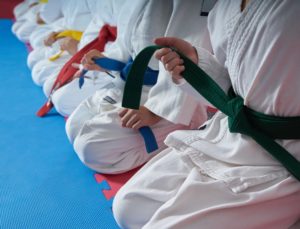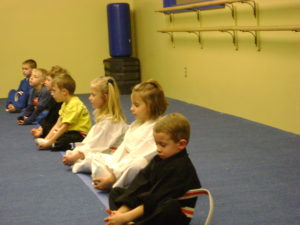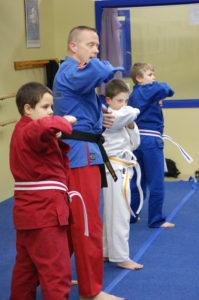 Here are some of the most Frequently Asked Questions…
Here are some of the most Frequently Asked Questions…
How much are Belt Tests?
All belt tests are $10 payable to Coach Arnold either previous to or at the time of the exam. This small fee covers the cost of the belt and certificate that comes with it. Due to the planning, set up, special certificate, and fees for the space, the testing fees for the (solid) Black Belt exam is $80 and comes with a personalized embroidered belt.
Please note that the youth belts for ages 5 – 12 are all white with a colored stripe running the length of the belt. After the black stripe belt (or when moving up into the teen/invite class) the student progresses into the solid belts. At the time of testing for the solid Black Belt, if the student is under the age of 15, they will earn the Junior Black Belt (Black Belt with White Stripe running the length of the belt).

At the teen class level (age 13) the student then moves to the solid belt level beginning with the solid gold belt. The solid Black Belt is awarded to ages 15 & up ONLY! (No exceptions!)
Special Note To Parents: There are a minimum number (70%) of classes required to test for the belt at the end of each quarter. (Attendance is taken at EVERY class!) Testing acts as a catalyst for standards and a means for gauging improvement in skills. Please be patient and understanding that this is not just tradition, but necessary to ensure that each student achieves a certain level of success with each subsequent test. (Much like learning anything else in a school setting, if you aren’t present for the instructional portion, then you aren’t as likely to be prepared for the final exam.)
Why do you only award the full Black Belt at 15? (XYZ School awards them much younger!)
The controversy surrounding the subject of awarding the Black Belt prior to a certain age has long been in  debate in martial arts circles. The issue becomes that of maturity level and age appropriate responsibility for the material being learned. Drinking age is 21, voting age is 18, driving age is 16, and yes I’ll even acknowledge that a permit is allowable for 15; the standard for these accepted ages revolves around the level of maturity as well as personal and social responsibility. The same standards are true for students of the martial arts. Consider the fact that a wide variety of techniques are taught to advanced level students purely for purposes of self defense and you immediately understand the implications. The moral, legal and ethical elements involved are something to be taken into consideration for both student and teacher as well. The next question that begs to be answered is can the Black Belt successfully defend his or her self? As professional martial artists we owe it to ourselves to ensure that the future of the martial arts rests in capable hands. A young adult may be able to take on this responsibility, but a child surely cannot. A young person should be molded and the physical skills fine-tuned; the level of understanding deepened to the point that they are fully prepared for the Black Belt at age 15 & up.
debate in martial arts circles. The issue becomes that of maturity level and age appropriate responsibility for the material being learned. Drinking age is 21, voting age is 18, driving age is 16, and yes I’ll even acknowledge that a permit is allowable for 15; the standard for these accepted ages revolves around the level of maturity as well as personal and social responsibility. The same standards are true for students of the martial arts. Consider the fact that a wide variety of techniques are taught to advanced level students purely for purposes of self defense and you immediately understand the implications. The moral, legal and ethical elements involved are something to be taken into consideration for both student and teacher as well. The next question that begs to be answered is can the Black Belt successfully defend his or her self? As professional martial artists we owe it to ourselves to ensure that the future of the martial arts rests in capable hands. A young adult may be able to take on this responsibility, but a child surely cannot. A young person should be molded and the physical skills fine-tuned; the level of understanding deepened to the point that they are fully prepared for the Black Belt at age 15 & up.
Do you teach adults?
I do, but only off-site.YES! Due to an increasing number of inquiries on my Personal Defense Training there is now an Adult Personal Defense class option in multiple formats. I have been teaching private and small group lessons to clients now since 1996. Amidst the growing concern for personal safety and well-being, I teach a very effective system of not just self defense, but awareness and survival principles. I have taught at local community centers, churches, small businesses, even quite a few private residences (back yards, garages, basements, and yes, even living rooms!)
What is in the Curriculum?
The current curriculum includes self defense oriented positions, strategies, and tactics all derived from traditional martial arts, military combatives, Western Boxing, Filipino martial arts, and Brazilian Jiu Jitsu.
What is the Rotating Curriculum?
The rotating curriculum is a new way to approach the study of the martial arts that has been very effective at increasing student success in the classroom. Under a rotating curriculum system, all students progress through the entire system and progress in skill level, thus earning a promotion at each level of proficiency.
How does the rotating curriculum affect the belt system?
It is very important to understand that the new system separates belts from curriculum. As before, students will progress from white to black belt. Also, the time requirements for each belt will not change. What has changed is that a student may be studying what used to be considered lower level material but at a higher belt level, or vice versa. It’s important to note that as long as the entire system is learned by black belt, the order does not matter. What does matter is a progression of improvement. Some outside observations are that the previous system was very linear in nature; this new system is much more circular.
What was the purpose behind moving to a rotating curriculum?
The rotating curriculum will help the instructors lead classes in a smoother and more efficient way. It will also create a sense of teamwork among our students by working with everyone in class equally rather than just those students of the same belt rank.
 How will a rotating curriculum help me as a student, or my child?
How will a rotating curriculum help me as a student, or my child?
The rotating curriculum will help all students to move at a more regular pace, meaning that students will not lag behind their teammates, creating a positive feeling of inclusion and self-worth.
Instructors will be able to identify right away the students that need help. It also means that students will receive the same level of instruction in a consistent manner. They also get to show leadership as they demonstrate and lead by example with balance, coordination, and dexterity.
It will help to develop more concrete, short-term goals for students. Students will learn new curriculum every few months, which will keep the study of martial arts fresh and exciting for them.
Overall, it will streamline and simplify both the classroom and the learning process so that students receive adequate instruction, attention, and practice to assure continued success.